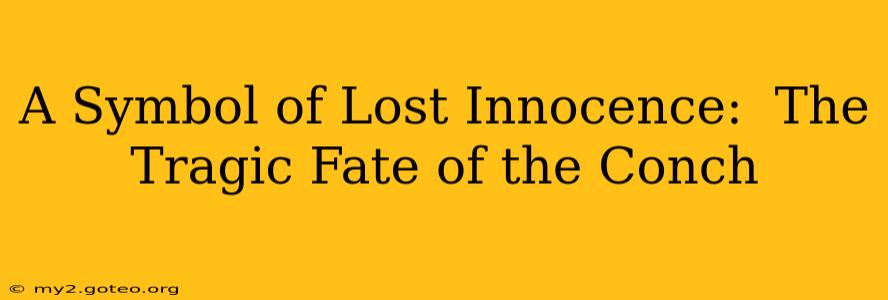The conch shell in William Golding's Lord of the Flies is far more than just a beautiful seashell; it's a potent symbol representing order, civilization, and most poignantly, lost innocence. Its journey from a symbol of hope and democratic process to a shattered relic mirrors the boys' descent into savagery, making it one of the most powerful and enduring symbols in 20th-century literature. This essay will explore the conch's significance, tracing its transformation and analyzing its ultimate fate as a reflection of the novel's central themes.
What does the conch symbolize in Lord of the Flies?
The conch initially embodies the boys' hope for rescue and their attempts to establish a civilized society on the deserted island. Its discovery by Ralph signifies the potential for order and rational leadership. The act of blowing the conch summons the boys together, establishing a democratic assembly where they can discuss their situation and make decisions collectively. This highlights the conch's association with democracy, reason, and the rule of law – all crucial aspects of a civilized society. The conch's inherent beauty also underscores the initial innocence and optimism of the boys, reflecting their belief in the possibility of maintaining order and returning home.
Why is the conch important to Ralph?
For Ralph, the conch represents his authority and legitimacy as leader. He uses it to call meetings, maintain order, and ensure that everyone has a voice. His grip on the conch is directly tied to his ability to govern and maintain control. As the boys descend into savagery, Ralph’s increasingly tenuous hold on the conch parallels his waning authority. The conch becomes a tangible manifestation of his struggle to uphold civility in the face of primal instincts. Its eventual destruction represents the complete erosion of his leadership and the triumph of savagery.
How does the conch's destruction symbolize the loss of innocence?
The shattering of the conch marks a crucial turning point in the novel. Piggy's death, which coincides with the conch's destruction, symbolizes the complete annihilation of reason, intellect, and civility. Piggy, the intellectual voice of reason and the embodiment of intellectual innocence, is brutally murdered by Jack's tribe. The act of smashing the conch is not just an act of violence against an object, but a symbolic annihilation of the boys' remaining hope for rescue and their potential for a civilized existence. It represents the final and irrevocable loss of their innocence, as the boys succumb entirely to their primal instincts.
What does the conch represent at the end of the novel?
By the novel's end, the conch lies in pieces on the sand, a silent testament to the boys' failed attempt to maintain order and civilization. The shattered conch serves as a grim reminder of their lost innocence and the destructive consequences of unchecked savagery. It is a powerful symbol of the fragility of civilization and the enduring power of primal instincts. The lack of any attempt to repair or even acknowledge the conch’s destruction reflects the complete moral decay that has consumed the boys.
Is the conch a symbol of hope?
Initially, yes, the conch is a powerful symbol of hope. Its discovery offers the boys a means of communication, organization, and the possibility of rescue. The sound of the conch evokes a sense of order and unity. However, as the novel progresses, this hope diminishes along with the conch's integrity, until it finally becomes a symbol of lost hope and the irreversible descent into savagery. The transition from hope to despair is mirrored in the conch's transformation from a symbol of unity to a symbol of utter destruction.
In conclusion, the conch in Lord of the Flies is far more than a simple object. It's a deeply symbolic representation of the boys' journey from innocent optimism to brutal savagery. Its fate mirrors their descent into primal instincts and serves as a chilling reminder of the fragility of civilization and the enduring power of human nature's darker aspects. Its tragic fate underscores Golding’s powerful message about the inherent darkness within humanity and the constant struggle between reason and savagery.

